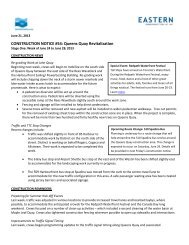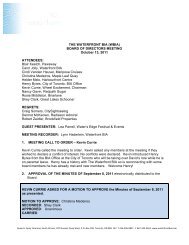Doors Open Toronto Press Release - Waterfront BIA
Doors Open Toronto Press Release - Waterfront BIA
Doors Open Toronto Press Release - Waterfront BIA
Create successful ePaper yourself
Turn your PDF publications into a flip-book with our unique Google optimized e-Paper software.
The <strong>Toronto</strong> Police Marine Unit staffs 38 Constables, 9 Sergeants, 2 Staff Sergeants, 1 Unit Commander, 4Mechanics, 2 Crew Hands, and 1 Civilian, totalling 57 personnel and is the largest command, encompassingapproximately 460 square miles of open water on Lake Ontario from the Etobicoke creek (Peel Region) to Rouge River(Durham Region) and extending 13 nautical miles to the US/Canada border. The <strong>Toronto</strong> Police Marine Unit isresponsible for all waterways within <strong>Toronto</strong> and has 3 sub-stations located at Bluffers Park, Centre Island and HumberBay Park, which all are used for police and lifeguard functions.NEW IN 2013 – TOUR THE WILLIAM LYON MACKENZIE FIREBOAT – TORONTO FIRE & MARINE STATION 334!Named for <strong>Toronto</strong>’s first mayor, the William Lyon Mackenzie Fireboat was built in 1964 by Russel Brothers Shipyardin Owen Sound, Ontario to provide marine fire protection, search and rescue on Lake Ontario, as well as ice breakingcapabilities for <strong>Toronto</strong>’s ferries and the Islands. The Fireboat is docked at <strong>Toronto</strong> Fire & Marine Station 334 (339Queen’s Quay West) and operates 12 months a year.The Fireboat is 24 metres long and weighs approximately 150 tonnes with a Caterpillar Diesel engine producing 3,000horsepower to achieve a top speed of 22 kilometres per hour. The vessel has a modified Tugboat hull and five tonnecrane as well as five water nozzles that can pump 50,000 litres of water a minute. The vessel is also equipped withradar, echo sounder, radio and daytime accommodation for the off-duty shift. In 2004, the vessel completed a $1million refurbishment that will extend the in-service life by approximately 30 years.TORONTO ON THE WATER, THE EXHIBIT RETURNS TO QUEEN’S QUAY TERMINALVisitors to Queen’s Quay Terminal can trace the visually stunning waterfront history through <strong>Toronto</strong> on the Water, aphoto exhibit that features over 100 archival images on loan courtesy of <strong>Toronto</strong> Star Archives, <strong>Toronto</strong> PortAuthority, City of <strong>Toronto</strong> Archives and Queen’s Quay Terminal. The exhibit will launch at <strong>Doors</strong> <strong>Open</strong> <strong>Toronto</strong>and will remain on display throughout the main level of Queen’s Quay Terminal until Labour Day. Admission is FREE.Relive memories of <strong>Toronto</strong>’s vibrant waterfront at <strong>Toronto</strong> on the Water. See images of ferries docked in <strong>Toronto</strong>Harbour (1910, <strong>Toronto</strong> Star Archives); Sunnyside Amusement Park was a popular summertime attraction until 1955when it was demolished to make way for the Gardiner Expressway (c.1925, <strong>Toronto</strong> Star Archives); Centre Island'sGibraltar Point Lighthouse, built 136 years ago at what was then the water's edge, is the city's oldest stone buildingand the oldest lighthouse on the Great Lakes, sand buildup over time has set it back about 100 metres inland. (1945,<strong>Toronto</strong> Star Archives); <strong>Toronto</strong> Island firefighters (1946, <strong>Toronto</strong> Star Archives) and the flying boat, the Santa Maria,of the U.S. and Cuban mail service, with the <strong>Toronto</strong> Harbour Commission building in the background (1921, <strong>Toronto</strong>Port Authority).<strong>Toronto</strong>’s rich history comes alive before your eyes at <strong>Toronto</strong> on the Water!Queen’s Quay Terminal was originally a cold storage warehouse facility. The Terminal Warehouse, built in 1926 byMoores and Dunford (NYC) was later converted to a condo/mall complex in 1983. The Terminal Warehouse was thefirst poured concrete building in Canada and one of the largest buildings in the country. The project architects, ZeidlerRoberts Associates of <strong>Toronto</strong> were respectful of the essential design character of the building and its references to ArtDeco were carefully maintained during all the alterations. The New York Times called it an example of successfulrevitalization efforts in <strong>Toronto</strong> during the 1980’s.THE TORONTO HARBOUR COMMISSION BUILDINGDesigned as the <strong>Toronto</strong> Harbour Commissioners headquarters and occupied by its successor, the <strong>Toronto</strong> PortAuthority, the <strong>Toronto</strong> Harbour Commission building is a fine example of Beaux-Arts Classicist architecture. Thebuilding was started in 1917 and completed in 1918. The spandrels are all embossed with "1917" on the building'sexterior, however. The building is constructed of concrete and faced primarily with Indiana limestone, with Queenstonlimestone around the bottom. It was designed by noted <strong>Toronto</strong> architect Alfred Chapman and built out into the harbourbefore infill later moved the water’s edge several hundred metres south. It is noted for its exterior details, such asCorinthian columns and spandrels, as well as its beautiful, original walnut-paneled boardroom and marbledentranceway. The <strong>Toronto</strong> Harbour Commission building is open to the public on Saturday only.
















